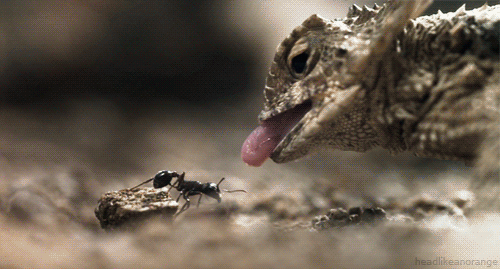
CHICAGO
JUNIOR HERP SOCIETY
Lizards

Hood expanded and mouth wide open, the Australian frilled lizard displays its threatening posture. Frilled lizards, or "frillnecks," are members of the dragon family that live in the tropical and warm temperate forests and savanna woodlands of northern Australia They vary in color and size from region to region. On average, the larger adults reach about 3 feet (0.9 meters) from head to tail and weigh up to 1.1 pounds (0.5 kilograms).

When born in captivity, they are quite docile and tolerant of interaction with humans. They are very active and predatory lizards, requiring a large amount of space to run. They prefer high temperatures, up to 105–110 °F (41–43 °C) at their basking spot and 80 °F (27 °C) elsewhere in their habitat during the day. Some collared lizards eat small amounts of fruit or vegetables, but most prefer a diet of insects. They will also consume vertebrate prey, including small mammals and other lizards.

Monitor lizards are generally large reptiles, although some can be as small as 20 centimetres (7.9 in) in length. They have long necks, powerful tails and claws, and well-developed limbs. Most species are terrestrial, but arboreal and semiaquatic monitors are also known. Almost all monitor lizards are carnivorous, although Varanus bitatawa, Varanus mabitang and Varanus olivaceus are also known to eat fruit. They are oviparous, laying from seven to 37 eggs, which they often cover with soil

May be either green or brown depending on environmental conditions, is a common lizard throughout Georgia and South Carolina, but is absent from some areas in the mountains. Anoles are generally arboreal (living in trees) but can be found almost anywhere. Anoles eat a wide variety of insects, spiders, and other invertebrates. They are complicated pets

Flying Dragon, a tree-dwelling lizard that can glide through the air from tree to tree. It grows to about eight inches (20 cm) long. A thin membrane covers false ribs extending outward from the flying dragon's body. Supported by this membrane, the animal can glide 50 feet (15 m) or more after leaping from a tall tree. It can turn in the air, and even return to the tree from which it jumped. The flying dragon feeds on insects and spiders. There are about 40 species of flying lizards in Asia

Bearded dragons make excellent reptile pets. With one of the best temperaments of all lizards, they are generally docile, and many seem to actually enjoy being handled When first born, baby bearded dragons are just under 4 inches in length and weigh about 1/10 of an ounce (2 1/2-3 grams). Adults typically are 19-23 inches and weight at least 3/4 of a pound (250 grams). The German giant morphn type can reach up to 26 inches in length

Babies can appear nearly FULL GROWN in one year depending on how much they're fed •Fairly large at mature size of around 20 inches (snout to vent length of 12 inches). •Life span of 10-20 years. •Ground dwellers with a flattened, elongated body (somewhat resembles a snake in appearance). •Quite docile and gentle, and quite easily tamed and handled.


The word iguana is derived from a Spanish form of the Taíno name for the species: iwana. Iguana iguana possess a row of spines along their backs and along their tails which helps to protect them from predators Iguanas are primarily herbivores, feeding on leaves, flowers, fruit, and growing shoots of upwards of 100 different species of plant
FACTS
! Lizards live chiefly in warm regions. Many inhabit deserts and semiarid regions; others live in fields and forests. Most dwell on the ground; some burrow into the soil; still others spend much of their time either in trees or in water.
! •It is possible for the Lizard to lose their tail when they feel that they are in danger. It can be a means of escaping from a predator. In time the tail will grow back again. The tail they leave behind will move and confuse the predator. What grows back will be slimmer and often a different color.
!•There are some species of Lizards with very small legs or have no legs. They are often mistaken though for a type of snake. One way to tell is to look for eyelids and to see if you can find external ears.
! •Lizards are able to smell by tasting the air around them. This is why they are often seen with their tongues going in and out at a rapid pace.
! •Most species of Lizards are amazing climbers. The Gecko is the fastest climber of all of them
! •Only some species of Lizards lay eggs. Others give live birth depending on the species

